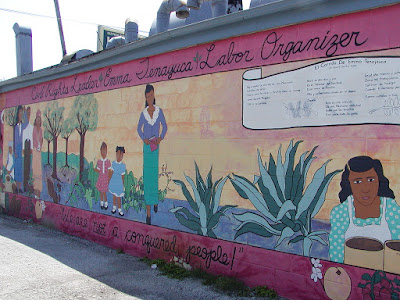Suburban DFW's Forgotten New Deal Colony, Part 1
The section of Arlington I went to grade school in
is a crazy quilt of rapid urban development. The shining new tract of
townhomes that we
moved into in the late 1970s jostled with looming mysterious pecan
orchards, lonely cowfields, straight broad new avenues, and a
sprawling (and miraculously still thriving) sprocket factory.
Just a quarter mile down the road
stands the portmanteau-cursed enclave of Dalworthington Gardens. In
that suburb inside a suburb, one could easily think it was a town
planned wholly by non-medicated schizophrenics. Old wooden shotgun
homes stand on long rectangle plots thick with livestock rub right up
against gated McMansions, checkerboarded with scraggly patches of
vestigial Cross-Timber woodlands. The only thing tying them together
seemingly being the immensity and uniformity of the multi-acre lots
and the shits not given to urban planning.
Except for those spare few minutes
ruminating in the car as I pull out of Mom's driveway, my brain never
dwells on this nowhere and everywhere town. Wholly by accident I
stumbled on a couple years that there is—or more accurately was—a
rhyme or reason to Dalworthington. And not only was I dead wrong
about the lack of plan behind the town, but the Plan was one of the
more interesting—if fleeting—experiments of the New Deal.
Let's back up to 1933.
Eliot Roosevelt, the son of the
president, has married into a local Fort Worth clan. Touring the area
with mom, Eleanor, they call on Carl Mosig, the Fort Worth bureau
editor of the Dallas Morning News, at
his 15-acre south Arlington homestead. Looking south from Arkansas Lane over
the empty land, Eleanor sees an ideal site for one of five Public
Works Administration planned “subsistence homesteads” to be
located in Dust Bowl-bombed Texas “to provide for aiding the
redistribution of the overbalance of population in industrial
centers.”
Curiously the subsistence homestead colonies are not
aimed directly at struggling farmers but at the swelling groups of
farmers and agricultural workers pushed of the land and into the
cities. Proletarianized and flitting around the edges of full time
industrial work, the colonies are supposed to supplement the life and
income of this part-time reserve army of labor by working their own
plots in literal garden towns.
A few short months later a local
21-person exploratory committee is appointed and picks out a nearby
600-acre cane-stubbled field area bounded by woods on the south. By
early 1934 large WPA work crews clear all the woods and build 34 new
houses arrayed around small farm plots. Workers erect a community house around
a 34-acre park, the planned heart of the community.
Dalworthington Gardens is born. And
despite it providing immediate economic relief to its carefully
screened settled residents (all making under $200/month household
income), its a hot, dusty, miserable treeless place at first.
There
are no paved roads, no fences to keep livestock in and out of fields.
No electricity or gas and the water pipes are tainted from a bordering
oilfield thanks to a crooked (later indicted) local contractor. The residents have to carry water by hand from a spring.
The families are paying for this misery
too, being required to pony up 10% of the cost of their homesteads
(albeit with generous loans with monthly payments capped at $25). Of the 52 families that move in in
1934, only 26 are left by 1935.
Today's post is running overlong.
Part Two tomorrow winds up the story through the late 1930s and
1940s. Also Part 2 gets us to the broader political punchline about
the tensions between the New Deal's reforms from above and the
roiling struggles from below in that period.





Fascinated. This will be read every time it's updated. My personal connection to these times is that my grandfather was a nurse at a CCC camp in the Black Hills in South Dakota.
ReplyDelete